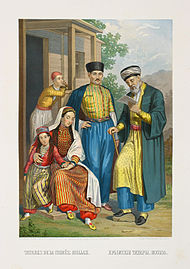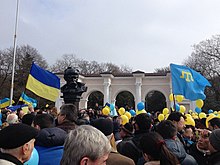Crimean Tatars
[10] The formation and ethnogenesis of Crimean Tatars lasted over 2500 years in Crimea and the Northern Black Sea region, uniting Mediterranean populations with those of the Eurasian Steppe.
[14][15] Russia attempted to purge Crimean Tatars through a combination of physical violence, intimidation, forced resettlement, and legalized forms of discrimination between 1783 and 1900.
[28][29] However, according to the Institute of Oriental Studies, due to negative situations, the real degree of threat has elevated to critically endangered languages in recent years, which are highly likely to face extinction in the coming generations.
[60][61][62] The primary contributor to the "sea pattern" of the Crimean Tatars is not the later migrations of Greeks from the Byzantine Empire, but rather the ancient populations from the city-states of the Eastern Mediterranean dating back to the 7th to 5th centuries BC.
This assertion is further substantiated by the analysis of the Crimean Tatar gene pool as revealed by the Human Origins full-genome panel data.
[67][13] The preliminary phase of the comprehensive analysis of complete Y-chromosomes, undertaken at the Laboratory of Genomic Geography of the N. I. Vavilov Institute of General Genetics of the Russian Academy of Sciences, focused on three specific haplogroups — G1, N3, and R1b — unveiled connections between the Crimean Tatars and the genomes of individuals from the Bronze Age steppes of Eurasia, specifically those associated with the Yamnaya archaeological culture, and the "European" (N3a3) and "Asian" (N3a5) Neolithic variants of haplogroup N3 in Northern Eurasia.
These findings may reflect not only the genetic legacy of the Scythians and Sarmatians but also more ancient affiliations between the populations of mainland Eastern Europe and the Crimean Peninsula.
[83] By the time of the first Russian invasion of Crimea in 1736, the Khan's archives and libraries were famous throughout the Islamic world, and under Khan Krym-Girei the city of Aqmescit was endowed with piped water, sewerage and a theatre where Molière was performed in French, while the port of Kezlev stood comparison with Rotterdam and Bakhchysarai, the capital, was described as Europe's cleanest and greenest city.
In the 17th century, the Crimean Tatars helped Ukrainian Cossacks led by Bohdan Khmelnytsky in the struggle for independence, which allowed them to win several decisive victories over Polish troops.
[92] In 1711, when Peter I of Russia went on a campaign with all his troops (80,000) to gain access to the Black Sea, he was surrounded by the army of the Crimean Khan Devlet II Giray, finding himself in a hopeless situation.
The Greeks paid dzhyziya, the Italians were in a privileged position due to the partial tax relief made during the reign of Meñli Geray I.
[98][99][81][100] For a long time, until the late 18th century, the Crimean Khanate maintained a massive slave trade with the Ottoman Empire and the Middle East which was one of the important factors of its economy.
[81] However, the Ukrainian historian Sergey Gromenko considers this testimony of Çelebi a myth popular among ultranationalists, pointing out that today it is known from the writings on economics that in the 17th century, the Crimea could feed no more than 500 thousand people.
After the annexation, the wealthier Tatars, who had exported wheat, meat, fish and wine to other parts of the Black Sea, began to be expelled and to move to the Ottoman Empire.
The bilingual Crimean Tatar-Russian newspaper Terciman-Perevodchik he published in 1883–1914, functioned as an educational tool through which a national consciousness and modern thinking emerged among the entire Turkic-speaking population of the Russian Empire.
[123] In May 1944, the entire Crimean Tatar population of Crimea was exiled to Central Asia, mainly to Uzbekistan, on the orders of Joseph Stalin, the General Secretary of the Communist Party of the Soviet Union and the Chairman of the USSR State Defense Committee.
Some modern researchers argue that Crimea's geopolitical position fueled Soviet perceptions of Crimean Tatars as a potential threat.
[126] This event is called Sürgün in the Crimean Tatar language; the few who escaped were shot on sight or drowned in scuttled barges, and within months half their number had died of cold, hunger, exhaustion and disease.
In effect, the government was punishing Crimean Tatars for being Stakhanovites while rewarding the deported nations that contributed less to the building of socialism, creating further resentment.
[137] Before the mass return in the perestroika era, Crimean Tatars made up only 1.5% of Crimea's population, since government entities at all levels took a variety of measures beyond the already-debilitating residence permit system to keep them in Central Asia.
A last-resort method to avoid a second deportation was self-immolation, famously used by Crimean Tatar national hero Musa Mamut, one of those who moved to Crimea without a residence permit.
[143] Many other famous Crimean Tatars threatened government authorities with self-immolation if they continued to be ignored, including Hero of the Soviet Union Abdraim Reshidov.
[150] Less than two years after Gromyko's commission had rejected their request for autonomy and return, pogroms against the deported Meskhetian Turks were taking place in Central Asia.
[152][153] Today, more than 250,000 Crimean Tatars have returned to their homeland, struggling to re-establish their lives and reclaim their national and cultural rights against many social and economic obstacles.
[156] Under the presidency of Viktor Yushchenko, increased attention was paid to Crimean Tatars, with trials for crimes against humanity beginning for those involved in the deportations.
[157] Following news of Crimea's independence referendum organized with the help of Russia on 16 March 2014, the Kurultai leadership voiced concerns of renewed persecution, as commented by a U.S. official before the visit of a UN human rights team to the peninsula.
[176] On the Nowruz holiday, Crimean Tatars usually cook eggs, chicken soup, puff meat pie (kobete), halva, and sweet biscuits.
The official goal of the NDKT during the Soviet era was the restoration of the Crimean ASSR under the Leninist principle of national autonomy for titular indigenous peoples in their homeland, conflicting with the desires of an independent Tatar state from the OKND, the predecessor of the Mejilis.
Yuri Osmanov, founder of the organization, was highly critical of Dzhemilev, saying that the OKND, the predecessor of the Mejilis, did not sufficiently try to mend ethnic tensions in Crimea.
The results of genomic studies indicate the preservation in the gene pool of Crimea of both the original "Mediterranean" component for more than 2.5 thousand years, and the later - "Eurasian steppe" component - in the northern steppe regions of Crimea.Crimean Tatars were excluded from the admixture analysis since their geographic position corresponds more to Europe rather than Central Asia, and their mtDNA pool is completely of West Eurasian origin.













